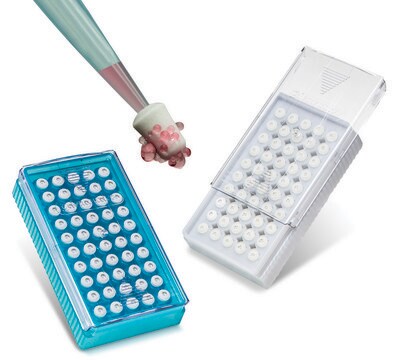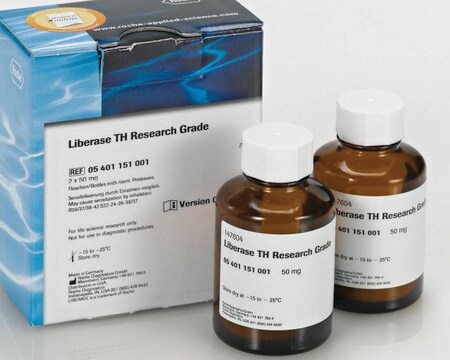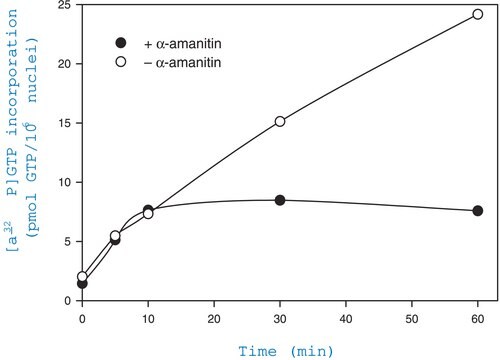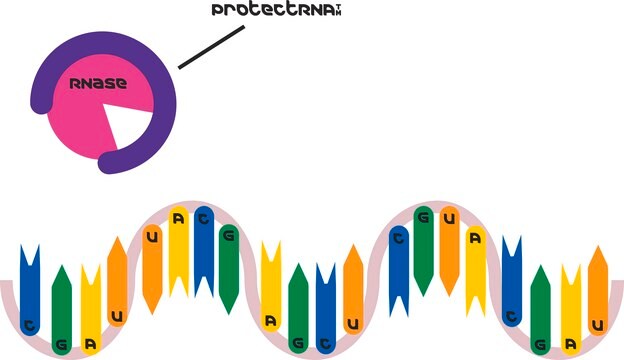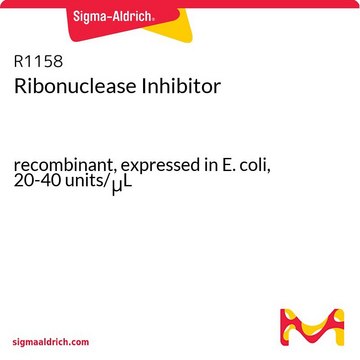추천 제품
분석
>95% (SDS-PAGE)
Quality Level
분자량
~50 kDa
포장
pkg of 10,000 U (03335402001 [5 x 2,000 U])
pkg of 2,000 U (03335399001)
제조업체/상표
Roche
파라미터
25-55 °C optimum reaction temp.
pH 범위
5.0-9.0
저장 온도
−20°C
일반 설명
Contents
Protector RNase Inhibitor (40 U/μl) in storage buffer: 20 mM HEPES-KOH, 50 mM KCl, 8 mM dithiothreitol, 50% glycerol (v/v), pH approximately 7.6 (+4°C).
Protector RNase Inhibitor (40 U/μl) in storage buffer: 20 mM HEPES-KOH, 50 mM KCl, 8 mM dithiothreitol, 50% glycerol (v/v), pH approximately 7.6 (+4°C).
Protector RNase Inhibitor inactivates a wide spectrum of RNases, including
- RNase A
- RNase B
- RNase T2
- protect mRNA during cDNA synthesis reactions, RT-PCR (in conventional thermal cyclers and qPCR systems), or in vitro transcription/translation reactions
- protect viral RNA during in vitro virus replication
- inhibit RNases during RNA isolation and purification
- be used in RNase protection assays
- help prepare RNase-free antibodies
특이성
Protector RNase Inhibitor (20 U/ 20 μl reaction) inhibits RNase A up to 1 ng, RNase B up to 160 pg and RNase T2 up to 0.03 U/μl reaction volume.
RNase H is not inhibited by Protector RNase Inhibitor.
Heat inactivation: > 65 °C
RNase H is not inhibited by Protector RNase Inhibitor.
Heat inactivation: > 65 °C
애플리케이션
Protector RNase Inhibitor may be used to:
- Protect mRNA in cDNA synthesis reactions, RT-PCR (in conventional thermal cyclers and qPCR systems), e.g., with the LightCycler® Instruments, in vitro transcription/translation system, RNase Protection Assay, in vitro RNA synthesis
- Protect viral RNA during in vitro virus replication
- Inhibit RNases during RNA isolation and purification
- Help prepare RNase-free antibodies
- Synthesize RNA probes for in situ hybridization
특징 및 장점
- Rely on a thermostable RNase inhibitor: Protector RNase Inhibitor remains stable even when using thermostable reverse transcriptases such as Transcriptor Reverse Transcriptase.
- Benefit from a wide range of reaction conditions: Protector RNase Inhibitor is active at pH 5.0 to 9.0 and at temperatures between +25°C to +55°C (partial activity is still measureable at +60°C).
- Eliminate interference in different RNA analysis applications: Maintain performance even when adding at 16-fold higher than the standard concentration.
- Insist on a highly-purified preparation: Each batch is function tested using techniques such as quantitative RT-PCR to ensure the absence of endonucleases, ribonucleases, or nicking activity, according to the current quality control procedures.
품질
Each lot of Protector RNase Inhibitor is function tested with the Titan One Tube RT-PCR Kit and the LightCycler DPD Kit. Protector RNase Inhibitor is also tested for contaminating activities as described below.
Test buffer: 50 mM Tris-HCl, 10 mM MgCl2, 0.1 mM EDTA, 7 mM β-Mercaptoethanol; pH 7.5 (+37°C).
Absence of endonucleases: 1 μg EcoR I/Hind III*-fragments of λDNA is incubated with Protector RNase Inhibitor in 50 μl test buffer at +37°C for 1 hour. The amount of inhibitor that causes no alteration in the banding pattern is stated under "Endo".
Absence of nicking activity: 1 μg supercoiled pBR322 DNA is incubated with Protector RNase Inhibitor in 50 μl test buffer at +37°C for 1 hour. The amount of inhibitor that causes no relaxation of supercoiled DNA is stated under "Nick. Act.".
Absence of ribonuclease (1): 5 μg of MS2 RNA is incubated with Protector RNase Inhibitor for 1 hour at +37°C in a final volume of 50 μl. The amount of inhibitor that causes no degradation of MS2 RNA is stated under "RNase 1".
Absence of ribonuclease (2): 5 μg of MS2 RNA is incubated with Protector RNase Inhibitor for 1 hour at +37°C, then 10 minutes at +65°C in a final volume of 50 μl. The amount of inhibitor that causes no degradation of MS2 RNA is stated under "RNase 2".
Test buffer: 50 mM Tris-HCl, 10 mM MgCl2, 0.1 mM EDTA, 7 mM β-Mercaptoethanol; pH 7.5 (+37°C).
Absence of endonucleases: 1 μg EcoR I/Hind III*-fragments of λDNA is incubated with Protector RNase Inhibitor in 50 μl test buffer at +37°C for 1 hour. The amount of inhibitor that causes no alteration in the banding pattern is stated under "Endo".
Absence of nicking activity: 1 μg supercoiled pBR322 DNA is incubated with Protector RNase Inhibitor in 50 μl test buffer at +37°C for 1 hour. The amount of inhibitor that causes no relaxation of supercoiled DNA is stated under "Nick. Act.".
Absence of ribonuclease (1): 5 μg of MS2 RNA is incubated with Protector RNase Inhibitor for 1 hour at +37°C in a final volume of 50 μl. The amount of inhibitor that causes no degradation of MS2 RNA is stated under "RNase 1".
Absence of ribonuclease (2): 5 μg of MS2 RNA is incubated with Protector RNase Inhibitor for 1 hour at +37°C, then 10 minutes at +65°C in a final volume of 50 μl. The amount of inhibitor that causes no degradation of MS2 RNA is stated under "RNase 2".
단위 정의
One unit of Protector RNase Inhibitor is defined as the amount of protein required to inhibit 50% of the activity of 5 ng RNase A.
Unit Assay: Activity is measured according to Blackburn as ability to inhibit hydrolysis of cyclic cytidine-2′ : 3′-monophosphoric acid. Under assay conditions, 200 U of Protector RNase Inhibitor inhibits 50% of the activity of 1 μg RNase A.
Volume Activity: 40 U/μl
Unit Assay: Activity is measured according to Blackburn as ability to inhibit hydrolysis of cyclic cytidine-2′ : 3′-monophosphoric acid. Under assay conditions, 200 U of Protector RNase Inhibitor inhibits 50% of the activity of 1 μg RNase A.
Volume Activity: 40 U/μl
제조 메모
Working concentration:
of inhibitor did not interfere with RT-PCR.)
- 5 to 10 U in One-step RT-PCR
- 25 to 50 U in Two step RT-PCR
- 20 U for in vitro transcription
of inhibitor did not interfere with RT-PCR.)
기타 정보
Product Specifications:
Source: Rat lung; Product is produced recombinant in E. coli
Isoelectric Point: pH 4.5
Temperature where Protector RNase Inhibitor is active: 25°C to +55°C; partial activity is still measurable at +60°C
Inactivation: Under severe denaturizing conditions (temperatures above +65°C), the inhibitor is inactivated
Bioburden: <50 cfu/ml
DNA Content: <100 pg/mg
Source: Rat lung; Product is produced recombinant in E. coli
Isoelectric Point: pH 4.5
Temperature where Protector RNase Inhibitor is active: 25°C to +55°C; partial activity is still measurable at +60°C
Inactivation: Under severe denaturizing conditions (temperatures above +65°C), the inhibitor is inactivated
Bioburden: <50 cfu/ml
DNA Content: <100 pg/mg
For life science research only. Not for use in diagnostic procedures.
법적 정보
NOTICE TO PURCHASER: DISCLAIMER OF LICENSE
This product is optimized for use in the polymerase chain reaction (PCR) covered by patents owned by F. Hoffmann-La Roche Ltd ("Roche"). No license under these patents to use the PCR Process is conveyed expressly or by implication to the purchaser by the purchase of this product. A license to use the PCR Process for certain research and development activities accompanies the purchase of certain Roche, Applied Biosystems or other licensed suppliers′ reagents when used in conjunction with an authorized thermal cycler, or is available from Applied Biosystems. Diagnostic purposes require a license from Roche. Further information on purchasing licenses may be obtained by contacting the Director of Licensing at Applied Biosystems, 850 Lincoln Centre Drive, Foster City, California 94404, USA.
This product is optimized for use in the polymerase chain reaction (PCR) covered by patents owned by F. Hoffmann-La Roche Ltd ("Roche"). No license under these patents to use the PCR Process is conveyed expressly or by implication to the purchaser by the purchase of this product. A license to use the PCR Process for certain research and development activities accompanies the purchase of certain Roche, Applied Biosystems or other licensed suppliers′ reagents when used in conjunction with an authorized thermal cycler, or is available from Applied Biosystems. Diagnostic purposes require a license from Roche. Further information on purchasing licenses may be obtained by contacting the Director of Licensing at Applied Biosystems, 850 Lincoln Centre Drive, Foster City, California 94404, USA.
LightCycler is a registered trademark of Roche
Storage Class Code
12 - Non Combustible Liquids
WGK
WGK 1
Flash Point (°F)
does not flash
Flash Point (°C)
does not flash
시험 성적서(COA)
제품의 로트/배치 번호를 입력하여 시험 성적서(COA)을 검색하십시오. 로트 및 배치 번호는 제품 라벨에 있는 ‘로트’ 또는 ‘배치’라는 용어 뒤에서 찾을 수 있습니다.
이미 열람한 고객
Monica Frinchi et al.
Acta histochemica, 115(3), 252-256 (2012-08-18)
Although connexin36 (Cx36) has been studied in several tissues, it is notable that no data are available on Cx36 expression in the carotid body and the intestine. The present study was undertaken to evaluate using immunohistochemistry, PCR and Western blotting
Jurgen Schnermann et al.
American journal of physiology. Renal physiology, 305(9), F1352-F1364 (2013-09-21)
Deletions of claudin-2 (Cldn2) and aquaporin1 (AQP1) reduce proximal fluid reabsorption (PFR) by about 30% and 50%, respectively. Experiments were done to replicate these observations and to determine in AQP1/claudin-2 double knockout mice (DKO) if the effects of deletions of
Stefanie Dukowic-Schulze et al.
Frontiers in plant science, 5, 57-57 (2014-03-13)
High-throughput sequencing has become the large-scale approach of choice to study global gene expression and the distribution of specific chromatin marks and features. However, the limited availability of large amounts of purified cells made it very challenging to apply sequencing-based
Adam D Langenbacher et al.
EvoDevo, 7, 9-9 (2016-04-14)
Germ cells are specified during early development and are responsible for generating gametes in the adult. After germ cells are specified, they typically migrate to a particular niche in the organism where they reside for the remainder of its lifetime.
Yoshihiro Komatsu et al.
Methods in molecular biology (Clifton, N.J.), 1092, 1-15 (2013-12-10)
In situ hybridization is a powerful method for detecting endogenous mRNA sequences in morphologically preserved samples. We provide in situ hybridization methods, which are specifically optimized for mouse embryonic samples as whole mounts and section tissues. Additionally, β-Galactosidase (β-gal) is
프로토콜
Protector RNase Inhibitor Protocol & Troubleshooting
관련 콘텐츠
Polymerase chain reaction (PCR) is a technique for amplifying nucleic acid molecules and is commonly used in many applications, including RT-PCR, hot start PCR, end point PCR and more.
자사의 과학자팀은 생명 과학, 재료 과학, 화학 합성, 크로마토그래피, 분석 및 기타 많은 영역을 포함한 모든 과학 분야에 경험이 있습니다..
고객지원팀으로 연락바랍니다.